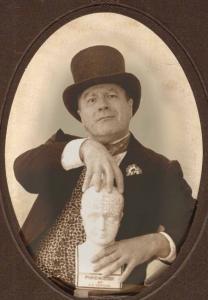Walter's Random Musings
9. Dancing in Weimar Berlin
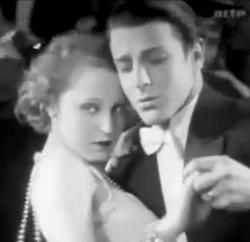 Germany during the era of the Weimar Republic (1919-1933) was a place of political conflict and economic chaos; as well as a nexus of cultural ferment, a flowering of invention and creativity, and a rejection of pre-Great War social norms and cultural conventions. It was also notorious for the vitality of its decadent night life, awash in sex and booze and jazz music: jazz music provided by hot German bands with their own distinctive national sound.
Germany during the era of the Weimar Republic (1919-1933) was a place of political conflict and economic chaos; as well as a nexus of cultural ferment, a flowering of invention and creativity, and a rejection of pre-Great War social norms and cultural conventions. It was also notorious for the vitality of its decadent night life, awash in sex and booze and jazz music: jazz music provided by hot German bands with their own distinctive national sound.
The dance of fashionable Weimar Germany was indistinguishable from the dancing you would see in London or New York. In the countryside or in "folk" events, you might well see good old fashioned rotary Waltzes, as well as dances like the Polka, Ländler, Zweifacher etc.; but in the night clubs of sophisticated cities like Hamburg or Berlin, only modern dances like the Foxtrot, Tango, Passo Doble and the "modern" Waltz were welcome. Occasionally, the Charleston would make an appearance.
Foxtrotting and Why it's Cool to be a Grown-up
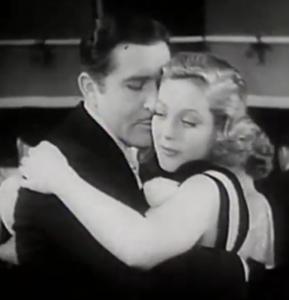 It's not a stunning revelation to say that dancing has changed a lot in the last half century. We all know that, but I don't know that most of us have really thought about the ways it has changed and how it reflects the ways our world has changed.
It's not a stunning revelation to say that dancing has changed a lot in the last half century. We all know that, but I don't know that most of us have really thought about the ways it has changed and how it reflects the ways our world has changed.
"Back in the day" which for my purposes, I will encapsulate in the 50 years between 1910 and 1960, dancing played a central role in the social lives of mature adults which it has entirely lost today. Today, among adults, with a few notable exceptions, almost nobody dances. Back then, almost everyone danced.
Night clubs, hotels, ocean liners and any place where people gathered to socialize had live music and a dance floor. Municipalities, corporations, fraternal lodges and community organizations sponsored dinner dances, where people got dressed up and men and women danced together - and their "signature" dance - by far the most popular and pervasive, was the Foxtrot. The dance floor was often too small, and it was crowded, but it was crowded precisely because almost everyone danced.
Starting in the early 20th Century, there was a clear distinction between Youth Dances and Adult Dances. The kids did the Charleston which became Collegiate, which became Swing, which became Rock & Roll (a species of Swing). Adults danced the Foxtrot, Tango and Waltz (but mostly Foxtrot) and occasionally Latin dances like Rumba, Samba, Cha Cha etc.(all fall in a category now referred to as "Ballroom Dances"). There was a distinctly adult way to dance and a distinctly kid way to dance, and when kids grew up, they gave up the wild kicks, spins, leaps and flying skirts and settled into a style more appropriate to their adult lives. We often refer to "Youth Culture" and tend fix on that when defining past decades in our minds, but we tend to overlook the fact that there was once an "Adult Culture" as well, which was much more ubiquitous and influential than the fads of wild youth.
So What's an iPad Good For?
 The library where I work recently purchased three iPads with an eye toward making a practical test of whether this new technology could be of use. The result has, so far, not been encouraging.
The library where I work recently purchased three iPads with an eye toward making a practical test of whether this new technology could be of use. The result has, so far, not been encouraging.
It recently fell to my lot to take a new look at this issue and figure out how iPads or other tablet computers could be useful in this business environment, so I conducted an informal survey at work and on Facebook to get an idea of what people were actually using the things for - and thereby perhaps get a sense of what we might use them for.
Before the list of uses, I would like to make an observation:
The most enthusiastic iPad users listed ways in which it excelled as an personal device. Its utility as a shared asset, such as we have in our library, seemed very limited.
A Few Words About Living in the Past
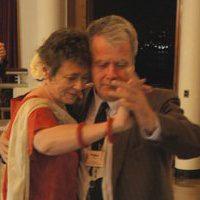 I received yet another email from a TV producer looking for people who live entirely in some sort of historical way. She gave me the sense that she really didn't understand us, and I fear that she was looking for subjects for a, not to put too fine a point on it, freak show like those I saw a few years back from the BBC. Here's how I responded:
I received yet another email from a TV producer looking for people who live entirely in some sort of historical way. She gave me the sense that she really didn't understand us, and I fear that she was looking for subjects for a, not to put too fine a point on it, freak show like those I saw a few years back from the BBC. Here's how I responded:
I understand there are some people who try to live entirely in some sort of "retro" way, but I don't know any. Everyone I know cherry picks from the past: we draw from the past the things we find lacking in the present, but we are perfectly willing to take advantage of modern technology and live in the real world. Most of us prefer not to live in a world with the disease, violence, bigotry and gender inequality that was all too common in the past, and there's few of us would turn down a shot of antibiotic if we had a serious infection.
Different people cherry pick different things. A lot of folks love the fashions of the past and enjoy the sense of occasion that really dressing up lends to any activity - something that is sadly lacking in our hyper-casual society. Many (and these groups contain lots of the same people) love the music and perhaps dance of the past - a time when songs were finely crafted and dances gave you a real connection to your partner.
Jazz Age Dance - Apologia
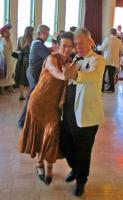 The initial motivation behind this project, to understand the most popular dances of the "Jazz Age", was frustration and confusion. THE big dance of the time was the Fox Trot, but the Fox Trot as I understood it just didn't seem right.
The initial motivation behind this project, to understand the most popular dances of the "Jazz Age", was frustration and confusion. THE big dance of the time was the Fox Trot, but the Fox Trot as I understood it just didn't seem right.
- The Fox Trot classes I had taken felt complicated and contradictory with seemingly random assortments of "quicks" and "slows" and memorized routines, some of which required me to count (I've never been good at math). It felt like I was getting pieces of a puzzle, without understanding how they fit together.
- The Fox Trot as I understood it and as I saw it performed by trained dancers, looked a bit like Fred and Ginger, but didn't look much like what I saw "regular folks" doing in old movies - and I have always been a bit more interested in regular folks rather than stars
- My Fox Trot wasn't much fun. How could such a dance have been so dominant and universally popular? How was it that this not very appealing dance (as I with my limited understanding understood it) was THE dance of the Jazz Age?
7. 1930s Conga
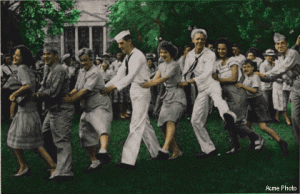 One of the more popular novelty dances of the late '30s was the Conga. Danced to a lively 4/4 beat with a strong accent on the fourth beat, the whole ballroom could join in.
One of the more popular novelty dances of the late '30s was the Conga. Danced to a lively 4/4 beat with a strong accent on the fourth beat, the whole ballroom could join in.
While I haven't found examples of the familiar one-two-three-kick Conga earlier than around 1938, I have seen occasional examples of spontaneous line dances popping up throughout our period. I think they are all, essentially, continuations of the old Cake Walk, and the Conga can be seen as a Latin accented Cake Walk.
The Conga Line is very familiar to most dancers of today. It usually involves a single leader, sometimes wielding a conga drum, doing a one-two-three-kick with a single file line, with everyone doing a slow forward shuffle and resting their hands on the person in front of them's shoulder or waist. This line wanders hither and yon, frequently off the dancefloor and all around the available space.
This particular figure was certainly common in the '30s, and is what your Conga will probably eventually devolve into, but there was a bit more variety to the original ballroom Conga. While it might be making an inevitable march towards a shuffling single file line, at least at the beginning of the dance, it could have a bit more in common with a Victorian Grand March.
It fequently began with a column of couples, ladies holding the gentlemen's arms, ladies on the right. The lead couple set a figure and everyone followed. Possible figures include:
5. 1930s Rumba
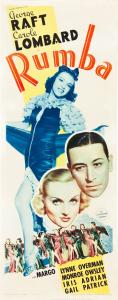 The 1930s saw the introduction of the Rumba (also spelled "Rhumba") to the North American and European ballroom. It was the result of applying a European ballroom dance vocabulary to a Latin beat. It began around 1930, and gradually grew in popularity through the '30s. By around 1935, it was a full fledged dance craze - though it never reached the heights of popularity enjoyed by the Foxtrot.
The 1930s saw the introduction of the Rumba (also spelled "Rhumba") to the North American and European ballroom. It was the result of applying a European ballroom dance vocabulary to a Latin beat. It began around 1930, and gradually grew in popularity through the '30s. By around 1935, it was a full fledged dance craze - though it never reached the heights of popularity enjoyed by the Foxtrot.
When it first arrived on the scene, dancers applied familiar moves to a new beat. In the videos in this collection, there is a sophisticated group of dancers from 1930 using Tango/Foxtrot styling to a Rumba beat.
While the classic Rumba box-step was being demonstrated by dance teachers as early as 1930, it took a few years for a distinctive style of Rumba to emerge among the general dance population that was significantly different from the Tangos and Foxtrots that came before, and part of its appeal was probably that it was a departure from the settled norms of the 1930s ballroom. First of all, unlike the "just walking" dances that had predominated since the Turn of the Century, it had that specific step.
The second was the tendency of the partners to separate, and even when they were together they had an open frame and were seldom in the close embrace of the Foxtrot. Underarm turns were common and "throw outs" were a frequent feature, and the dancers even separated to do their own little personal Rumba before linking back up to their partners.
The Rumba also had an element of showmanship, of showing off, that had definitely not been part of mainstream social dancing. Certainly Swing dancers were all about putting on a show, but Swing, with its popularity among African Americans and the white kids who emulated them, was not seen in the clubs and ballrooms of adult white "polite society".
Thos Wilson's Quadrille Instructor - Ca 1816
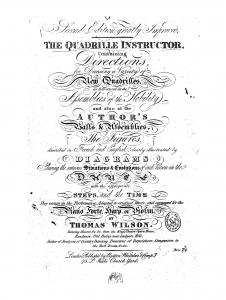
The Quadrille Instructor,
Containing Directions, for Dancing a Variety of New Quadrilles, as Introduced at the Assemblies of the Nobility and also at the Author's Balls & Assemblies.
The Figures, described in French and English, clearly illustrated by Diagrams Shewing the various Situations & Evolutions of each Person in the Dance, with the appropriate Steps and the Time they occupy in the Performance.
Adapted to original Music, and arranged for the Piano Forte, Harp, or Violin,
by Thomas Wilson
This compact book of instructions discusses the quadrille at the time it was being invented. In geometry, these early quadrilles were very much like later Victorian quadrilles (and American Square Dances for all that). However, the Victorians had largely given up on the steps that are such an integral part of the Regency Quadrille.
The publication date is an estimate. The book is not dated, but the text refers to a long forgotten French opera about the Duke of Wellington, and it seems unlikely that the French would be writing operas about the Iron Duke before the Battle of Waterloo - and also mentions "Treasures of Terpsichore", which is dated 1816.
8. Bal Musette: Parisian Dance of the Jazz Age
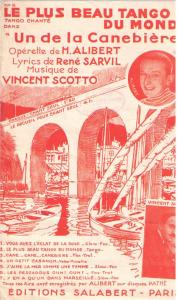 I include this as a distinct heading, since Paris in the "Jazz Age", while absorbing the influences of the US and other countries, had its own distinctive style of dance. Given that Jazz Age Paris was the world capital of fashion, art and intellectual ferment, I think it appropriate that a survey of Jazz Age dance should take a moment to look at how people were dancing in the world of Chanel, Hemingway, Piaf and Picasso. The style of dancing seems to have persisted with very little change until the inexorable march of Rock and Roll eclipsed it in the '60s.
I include this as a distinct heading, since Paris in the "Jazz Age", while absorbing the influences of the US and other countries, had its own distinctive style of dance. Given that Jazz Age Paris was the world capital of fashion, art and intellectual ferment, I think it appropriate that a survey of Jazz Age dance should take a moment to look at how people were dancing in the world of Chanel, Hemingway, Piaf and Picasso. The style of dancing seems to have persisted with very little change until the inexorable march of Rock and Roll eclipsed it in the '60s.
While lumping it all under the title of "Bal Musette" may not be precisely correct, since there was plenty of dancing taking place in France in places other than Bals Musettes (upscale nightclubs, private parties etc. for example), it is a convenient shorthand for this distinctive French style.
A "Bal Musette" was an informal sort of dance, hosted in bars, restaurants and dance halls, open all to social classes and often with a decidedly down market feel. It was danced on a small dance floor with a modest band (trio, quartet, quintet) that nearly always featured a "musette" accordion.
Elizabethan Dining
The Ample Pleasures of the English Table
The Elizabethan, like ourselves, generally ate three meals a day. The first was breakfast, which was eaten shortly after rising, but not before attending morning services (farmers wouldn't have time in the morning to attend services any day but Sunday, but pious townsmen, the gentry and their servants often did go to the chapel daily). Breakfast was a small, simple meal, generally consisting of cold foods, as the cook fires were just being lit as the breakfasters were rising. Leftovers, eggs, butter, bread and small beer were commonly taken with breakfast.
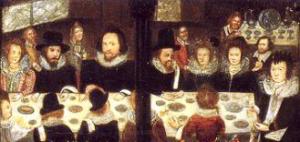 But, since breakfast was by definition eaten early, those who did not rise early did not eat it. Unless they were traveling or fond of the hunt, nobles generally did not rise early enough to eat breakfast, and dispensed with it in favor of a hearty mid-day meal. Working men and women however, who rose with the sun, seldom failed to fortify themselves against the day.
But, since breakfast was by definition eaten early, those who did not rise early did not eat it. Unless they were traveling or fond of the hunt, nobles generally did not rise early enough to eat breakfast, and dispensed with it in favor of a hearty mid-day meal. Working men and women however, who rose with the sun, seldom failed to fortify themselves against the day.


